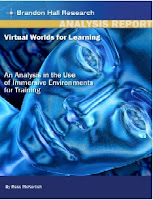
Be sure to check out this analysis report. The Brandon Hall Research Analysis just published "Virtual Worlds for Learning: An Analysis in the Use of Immersive Environments for Training by Ross McKerlich.
 Virtual worlds such as Second Life are attracting interest from organizations as platforms for learning. Also known as immersive environments, these systems can provide many significant advantages over other learning strategies. As with anything, knowing the basics is crucial before deciding. By understanding what virtual worlds are, their uses as a learning technology, what differentiates them from other learning technologies, and their pros and cons, businesses are able to make a more informed decision regarding using virtual worlds for learning.
Virtual worlds such as Second Life are attracting interest from organizations as platforms for learning. Also known as immersive environments, these systems can provide many significant advantages over other learning strategies. As with anything, knowing the basics is crucial before deciding. By understanding what virtual worlds are, their uses as a learning technology, what differentiates them from other learning technologies, and their pros and cons, businesses are able to make a more informed decision regarding using virtual worlds for learning.About Ross McKerlich
 He is a distance education professional and an education technology enthusiast. Ross was introduced to virtual
He is a distance education professional and an education technology enthusiast. Ross was introduced to virtual
worlds in a graduate course, and has been immersed ever since in the challenge of adding this technology to the educator’s tool chest.
In addition to research and writing for Brandon Hall Research, Ross owns his own consulting company called Centerboard Strategic Learning. (www.centerboard.ca).
Ross has a master’s degree in distance education, a diploma in adult education and a bachelor of arts degree. He lives in Kelowna, B.C.,Canada with his wife and two sons, and loves sailing and other outdoor pursuits.
Source: Brandon Hall Research











